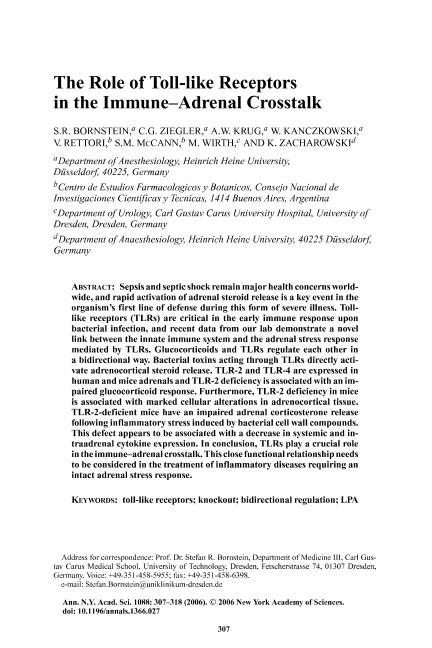Mostrar el registro sencillo del ítem
dc.contributor.author
Bornstein, S. R.
dc.contributor.author
Ziegler, C. G.
dc.contributor.author
Krug, A. W.
dc.contributor.author
Kanczkowski, W.
dc.contributor.author
Besuhli, Valeria

dc.contributor.author
McCann, S. M.
dc.contributor.author
Wirth, M.
dc.contributor.author
Zacharowski, K.
dc.date.available
2017-07-12T19:42:59Z
dc.date.issued
2006-11
dc.identifier.citation
Bornstein, S. R.; Ziegler, C. G.; Krug, A. W.; Kanczkowski, W.; Besuhli, Valeria; et al.; The role of toll-like receptors in the immune–adrenal crosstalk; Wiley; Annals of the New York Academy of Sciences; 1088; 11-2006; 307-318
dc.identifier.issn
0077-8923
dc.identifier.uri
http://hdl.handle.net/11336/20261
dc.description.abstract
Sepsis and septic shock remain major health concerns worldwide, and rapid activation of adrenal steroid release is a key event in the organism's first line of defense during this form of severe illness. Toll-like receptors (TLRs) are critical in the early immune response upon bacterial infection, and recent data from our lab demonstrate a novel link between the innate immune system and the adrenal stress response mediated by TLRs. Glucocorticoids and TLRs regulate each other in a bidirectional way. Bacterial toxins acting through TLRs directly activate adrenocortical steroid release. TLR-2 and TLR-4 are expressed in human and mice adrenals and TLR-2 deficiency is associated with an impaired glucocorticoid response. Furthermore, TLR-2 deficiency in mice is associated with marked cellular alterations in adrenocortical tissue. TLR-2-deficient mice have an impaired adrenal corticosterone release following inflammatory stress induced by bacterial cell wall compounds. This defect appears to be associated with a decrease in systemic and intraadrenal cytokine expression. In conclusion, TLRs play a crucial role in the immune–adrenal crosstalk. This close functional relationship needs to be considered in the treatment of inflammatory diseases requiring an intact adrenal stress response.
dc.format
application/pdf
dc.language.iso
eng
dc.publisher
Wiley

dc.rights
info:eu-repo/semantics/openAccess
dc.rights.uri
https://creativecommons.org/licenses/by-nc-sa/2.5/ar/
dc.subject.classification
Otras Ciencias Médicas

dc.subject.classification
Otras Ciencias Médicas

dc.subject.classification
CIENCIAS MÉDICAS Y DE LA SALUD

dc.title
The role of toll-like receptors in the immune–adrenal crosstalk
dc.type
info:eu-repo/semantics/article
dc.type
info:ar-repo/semantics/artículo
dc.type
info:eu-repo/semantics/publishedVersion
dc.date.updated
2017-07-11T19:46:12Z
dc.identifier.eissn
1749-6632
dc.journal.volume
1088
dc.journal.pagination
307-318
dc.journal.pais
Estados Unidos

dc.journal.ciudad
Hoboken
dc.description.fil
Fil: Bornstein, S. R.. Heinrich Heine University; Alemania
dc.description.fil
Fil: Ziegler, C. G.. Heinrich Heine University; Alemania
dc.description.fil
Fil: Krug, A. W.. Heinrich Heine University; Alemania
dc.description.fil
Fil: Kanczkowski, W.. Heinrich Heine University; Alemania
dc.description.fil
Fil: Besuhli, Valeria. Consejo Nacional de Investigaciones Científicas y Técnicas. Oficina de Coordinación Administrativa Houssay. Centro de Estudios Farmacológicos y Botánicos. Universidad de Buenos Aires. Facultad de Medicina. Centro de Estudios Farmacológicos y Botánicos; Argentina
dc.description.fil
Fil: McCann, S. M.. Consejo Nacional de Investigaciones Científicas y Técnicas. Oficina de Coordinación Administrativa Houssay. Centro de Estudios Farmacológicos y Botánicos. Universidad de Buenos Aires. Facultad de Medicina. Centro de Estudios Farmacológicos y Botánicos; Argentina
dc.description.fil
Fil: Wirth, M.. University of Dresden; Alemania
dc.description.fil
Fil: Zacharowski, K.. Heinrich Heine University; Alemania
dc.journal.title
Annals of the New York Academy of Sciences

dc.relation.alternativeid
info:eu-repo/semantics/altIdentifier/url/http://onlinelibrary.wiley.com/doi/10.1196/annals.1366.027/abstract
dc.relation.alternativeid
info:eu-repo/semantics/altIdentifier/doi/http://dx.doi.org/10.1196/annals.1366.027
Archivos asociados
